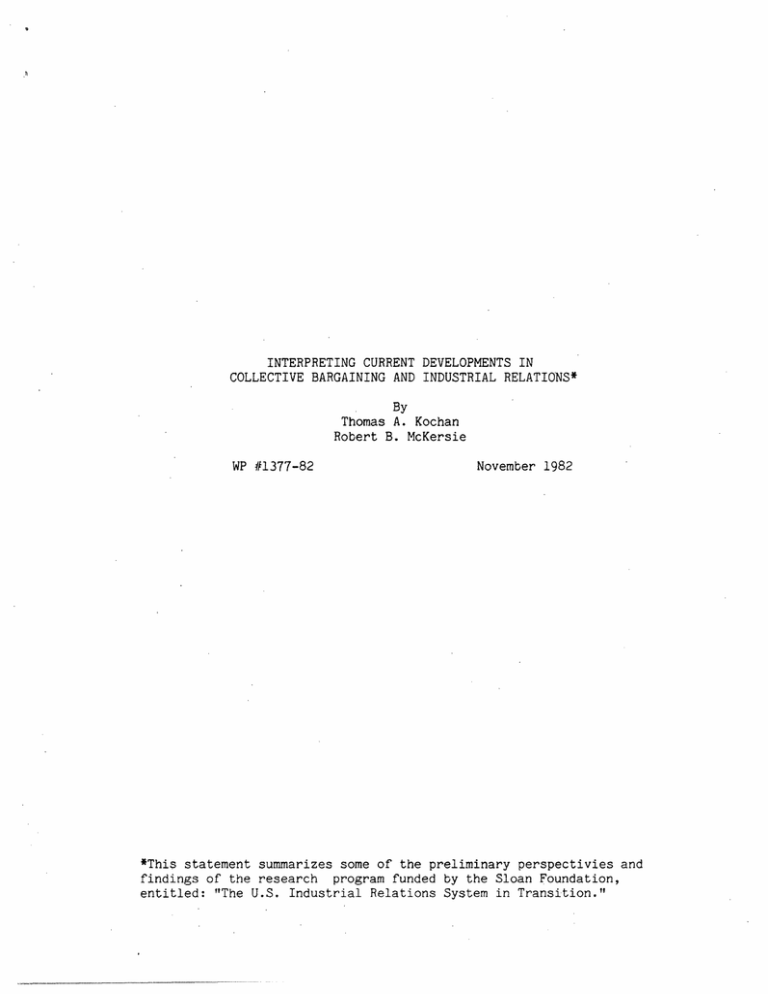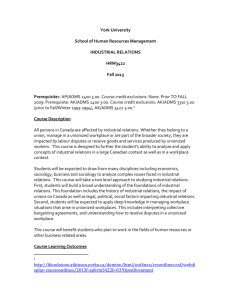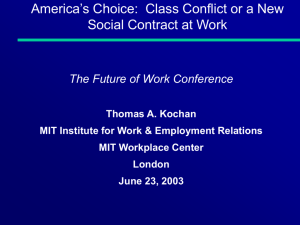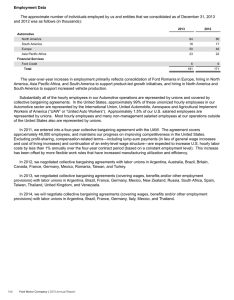INTERPRETING CURRENT DEVELOPMENTS IN By Thomas A. Kochan
advertisement

INTERPRETING CURRENT DEVELOPMENTS IN COLLECTIVE BARGAINING AND INDUSTRIAL RELATIONS* By Thomas A. Kochan Robert B. McKersie WP #1377-82 November 1982 *This statement summarizes some of the preliminary perspectivies and findings of the research program funded by the Sloan Foundation, entitled: "The U.S. Industrial Relations System in Transition." ·^I ___ ______I_______ INTERPRETING CURRENT DEVELOPMENTS IN COLLECTIVE BARGAINING AND INDUSTRIAL RELATIONS* It is becoming increasing clear that the practice of industrial relations in the private sector has changed in a number of important ways in recent years. While the most visible examples of change may lie in the numerous wage, fringe benefit, work practice, and employment security concessions and tradeoffs negotiated in 1981 and 1982, other important changes are occuring more quietly with employers, unions, and to some extent government agencies. We believe that an understanding of these changes and their long-run implications for industrial relations can best be obtained by broadening the focus of the analysis of industrial relations at the level of the firm. Particularly, it is important to look both above and below our traditional focus on the level at which collective bargaining formally occurs. Instead, we need to examine changes occuring at the highest levels of strategic decision making within firms and unions, relate these strategies to the conduct and results of collective bargaining, and then go on to look at significant changes occuring in the conduct of industrial relations at the level of the workplace. Indeed, based on preliminary evidence from our current research, we believe that the U.S. system of industrial relations is undergoing one of its periodic, albeit infrequent, periods of fundamental change or transition. If our view is correct, the strategic choices that labor, management and government officials are now making will have long term consequences for the performance of the American industrial relations system. This statement has been prepared by Thomas A. Kochan and Robert B. McKersie and summarizes some of the preliminary perspectives and findings of the research program funded by the Sloan Foundation, entitled: "The U.S. Industrial Relations System in Transition." These changes, however, are not occuring universally across organizations or collective bargaining relationships. single pattern of change emerging. Nor is a Instead, the variety of choices being made by the parties may produce an even wider diversity of practices and results than was the case in previous years. Nor are these strategic choices or changes occuring unrelated to other developments. Just as industrial relations has always been influenced by environmental pressures, the changes occuring within firms and unions are partly a product of incremental environmental pressures that have built up through the 1970s and that are now coming together in ways that escalate the pressure for adjustment. Pressures for Change The 1970s was a decade in which the pressures for change in the unionized sector of the American economy were gradually building, however, the parties did not respond accordingly. Instead, the patterns of behavior built up in the post-World War period of the growth and evolution of collective bargaining continued to dominate the behavior of industrial relations professionals within management, and the process and results of collective bargaining. Consequently during the 1970s a gap developed between internal practices in industrial relations and external environmental pressures. For example, the key economic development of the 1970s was the comOination of the growth in competitive pressures on the unionized sectors of the American economy and the rapid and persistant rates of inflation. The sources of the increased competitive pressures varied from industry to industry including increases in international competition, the rise of domestic non-union competition, and more recently the deregulation of key sectors of the economy. These -2- pressures have now been accelerated by the force of the current recession. ecause of the inflationary pressures of the 1970s and the expansion of cost-of-living escalators in collective bargaining agreements, the differentials in compensation costs between domestic union firms and their domestic and foreign competitors increased. Thus, the economic pressures that were building incrementally during the seventies interacted with the cyclical pressures of the 1980-82 recession and help explain some of the changes currently occuring within firms. While these economic pressures were building, pressures for changes in collective bargaining were also coming from other aspects of the environment. Jobs moved from the strongholds of unionism in the North to the Sun Belt. Technological changes and improvements in transportation have made it more attractive for some firms to establish new smaller plants in rural and low labor cost regions of the country rather than to reinvest in existing facilities. Shifts in both the supply and the demand for labor have produced higher rates of growth in occupations outside of the traditional blue collar base of union membership. Finally, the swing toward conservatism in the political climate of the country has interacted with the economic pressures outlined above to put pressure on the collective bargaining system. The most significant response of the industrial relations system in the U.S. to these pressures that were building between 1960 and 1980 did not occur within collective bargaining. Instead, American management chose to take a relatively status quo or incremental adjustment approach to collective bargaining while at the same time taking steps to contain the expansion of trade unions or to -3- avoid unionism altogether in the growth sectors of the economy. Indeed, the development of sophisticated non-union human resource management policies and strategies may turn out to be the most significant development in American industrial relation system of the last two decades. While no aggregate quantitative data are yet available for comparing the characteristics of the union and non-union sectors of the American economy, it is clear that the unionized sector is largely the product of the mass organizing drives in the manufacturing, transportation, mining, utilities, and communications industries of the 1930 to 1950 time period. These are now the mature or declining sectors of the American economy. While some of these firms and industries continue to grow, a higher percentage of the new entrants and the new establishments opened by existing firms operate without a union than was the case of similar expansions or entrants in the 1940-1959 time period. Thus we now have a bi-modal distribution of union and non-union establishments. Union members are currently concentrated in the older industries, the older firms, and the older plants of firms that are partially unionized. While we have traditionally tended to think of the non-union sector as following the wage, fringe benefit, and personnel practices of unionized firms, the current period appears to be more one of transition in which the innovations developed in human resource management in the non-union sector are now being experimented with in unionized firms. Two examples illustrate this point. The first involves strategies for promoting employment continuity. By emphasizing broad banded job classifications and descriptions, transfer, retraining and -4- attrition programs, and sophistocated human resource planning many large non-union companies have been able to manage their internal labor market so that few if any workers are separated involuntarily. Correspondingly, within the unionized sector the realization has crystallized that the practice of "parking the labor force outside the door" when demand falls off has been costly and has fostered an atmosphere of insecurity and instability. Consequently, the decision by Ford Motor and the UAW to experiment with the concept of employment guarantees at two plants is an important example of what may be a new trend in the unionized sector. The second example is that of communications programs. In the absence of unions, management has been able to communicate directly with workers, usually using first line supervisors as the delivery point for information about the future of the business. Until recently, companies with collective bargaining agreements found it difficult to do any extensive communication on a direct basis with employees. Some of the reluctance can be traced back to the era of collective bargaining history referred to as Boulwarism when General Electric and several other companies followed the practice of communicating directly with their workers in an effort to convince them of the fairness and rightness of management's position during contract negotiations. When this approach was declared an unfair labor practice by the NLRB a certain "chilling" took place with respect to communications activity in unionized plants. More recently, however, communications techniques that have been developed with great sophistocation, both with respect to substance and media, in the nonunion sector have been applied more and more actively in the organized sector. -5___1__1__1__111___ _ A good deal of the need III for more communication has been stimulated by concession bargaining and by a realization on the part of companies that worker expectations were often far out of touch with the competitive realities being faced by those organizations. More and more unionized companies have realized that they must now find ways to communicate effectively with both union leaders and rank and file workers. Changes in Managements' Industrial Relations Strategies We can further expand on the changes that we see currently underway in industrial relations in selected unionized firms by examining developments in the management of industrial relations at the levels of corporate strategy, collective bargaining, and the workplace. Changes at the Corporate Level During the past twenty years many labor relations professionals within unionized corporations became increasingly isolated, conservative, and less influential. Because labor relations managers were primarily concerned with maintaining stable and peaceful union-management relations, they neither made aggressive attempts to change work practices or to change significantly wage and fringe benefit formulas or patterns. Nor did they readily accept the need to introduce direct strategies for involving workers and unions in efforts to improve the quality of working life and productivity. Thus they remained focused on the traditional collective bargaining activities and responsibilities. Meanwhile, the growth of government regulations, the increase in the demand for managers, professionals, and technical employees, and the increasing interest in union -6- avoidance among top executives led to the development of a new set of human resource management specialists who were more conversant with different types of planning, behavioral-science based innovations in work organization and personnel systems, and organizational-change techniques that now form the foundation for non-union human resource management systems. Because of the importance of these functions to top executives, and because of the increasing importance of the government regulations and tight labor markets for professionals, human resource specialists have gained power and influence while the traditional labor relations specialists have lost power. This gradual evolution has laid the foundation for the current. transformation in the conduct of industrial relations that appears to be taking place in many firms. The nature of this transformation in the role of industrial relations professionals can be seen in several ways. For example, the economic crisis facing many companies has highlighted the link oetween overall business policy and strategy and industrial relations and collective bargaining. Decisions regarding investment in different businesses or plants have traditionally been isolated from most of the industrial relations professionals within corporations. New demands for concessions from unions, however, coupled with countervailing demands for greater information sharing on the part of unions, are forcing a closer link between investment (and other basic business decisions) and the industrial relations function. This in turn is calling on industrial relations and human resource management professionals to engage in more long-term planning and strategic analysis of alternatives for reducing labor costs and increasing productivity. Indeed, the. drive for productivity improvement and -7- ____I laOor cost control is forcing corporations to forge a closer link between operating or line managers and the labor relations and personnel specialists. Thus, the techniques of strategic planning and analysis are beginning to get introduced more directly into the industrial relations function than in prior years. Also, a wider group of managers have often been part of the planning and the development of strategy for contract negotiations than in the past. Another development of significance has been the high level of visibility given to worker participation and involvement in Japan and in many non-union companies. These models have caught the interest and attention of many top executives outside of the industrial relations function. This has led to an increase in corporate efforts to develop new patterns of communication and involvement with individual employees and in small groups to both improve employee commitment to the firm and to increase productivity. These efforts have again required industrial relations managers to develop new strategies for not only working with trade union leaders but to involve individual employees and bring about higher levels of trust and involvement at the work place. Again, the skills and techniques required to implement this strategy require active cooperation between organizational development specialists and traditional industrial relations specialists. In short, the role of industrial relations within many corporations is undergoing fundamental change as companies search for new strategies that link their industrial relations performance to the larger business strategies of the firm and efforts to reduce labor costs, increase productivity, and enhance the commitment and participation of individual workers. -8- Changes in Collective Bargaining The major changes occuring in collective bargaining are easily summarized because of their high visibility. Recent data from BLS indicate that the rate of increase in major collective bargaining agreements in the first six months of 1982 was 3% compared to an average of 9.8% for calendar year 1981. Furthermore, 58% of the workers covered under contracts negotiated during these first six months provided for no wage increase in the first year and 55% provided for no wage increase over the term of the agreement. Any average settlement figure misses important variations that always occur. In fact, this year we appear to be facing a larger than normal dispersion in settlement rates. While certain industries have negotiated wage freezes, deferals, or wage cuts, other firms and industries under less intensive pressures have tended to settle at levels only marginally lower than settlements in earlier years. For example, if the auto and trucking settlements are eliminated from the BLS figures on major settlements for the first six months of 1982, the employees covered under the remaining agreements settled for approximately 7.8%. Another indication of a major departure from previous trends can be seen in the number of early contract negotiations such as in the auto, trucking, and steel industries. Perhaps even more significantly, 1982 appears to have brought about a renewal of plant specific bargaining over work practices, particularly over the scope of job definitions and classifications, rules governing the movement of people across jobs through bidding and posting procedures and bumping rights, and general plant practices that affect the flexibility and the use of human resources and payment for time not -9- ·__ XII worked. These all represent efforts to gain control over manufacturing costs, reduce compensation differentials with nonunion competitors, and achieve greater flexibility in the allocation of human resources. Workplace Level Changes Finally, a significant increase in the attention paid to the degree of involvement, commitment, and participation of individual workers and work groups in task related decisions has resulted from both the corporate strategy efforts reviewed above and the efforts to bring about changes in work rules and practices at the plant level through collective bargaining. Indeed, while a number of quality of working life (QWL) efforts were started in the late 1960s and early 1970s, most of them deemphasized productivity issues and separated QWL efforts from the collective bargaining process and relationship. The current round of employee participation efforts are addressing more directly issues affecting work organization and productivity and in some instances are fostering innovations that are at variance with the provisions found in bargaining agreements. For example, as QWL programs grapple with operating problems they are bound to get into issues involving the scope of jobs and provisions for moving workers across jobs. This leads to questions concerning the role of seniority, the compensation and job evaluation systems, and the promotion, transfer, and bumping rights of different workers. What appears to be of highest priority to managers is to achieve the type of broad banded jobs and higher degrees of flexibility in the assignment and utilization of people that are associated with the newer forms of work organization found in many innovative non-union firms. How employee involvement programs and the dictates of -10- contracts and collective bargaining sort out their differences remains to be seen. Labor Movement Strategies Most of the analysis to this point has focused on changes in industrial relations resulting from the more proactive behavior on the part of employers. Union leaders are, however, also facing a number of strategic choices which will influence their future roles in the U.S. industrial relations system. Some of the issues facing unions at the three levels of industrial relations can be seen in a number of recent developments. Traditionally, the main point of contact for unions in industrial relations has been at the middle point of the three tiered framework discussed above, namely at the level at which unions negotiate collective bargaining agreements with individual firms. Presently, however, we see considerable thought and experimentation being given to greater involvement by unions at levels both below and above the level of contract negotiations. At the lowest level of industrial relations, i.e., in the relationship between individuals, work groups, and supervisors, unions are currently being challenged by quality of working life and other employer efforts to more fully involve workers in the ongoing processes of the organization. These efforts entail a "mixed bag" of risks and opportunities for local unions. Union leaders can play important roles in setting the stage for, designing, and administering participation programs and thereby attempt to integrate them into their representational role at the workplace. On the other hand, over time, these efforts are likely to both build higher commitment of the worker to the firm, challenge existing work rules, -11I_ III and fashion new work organization arrangements. If this occurs, local unions no doubt will find it necessary to modify their traditional roles at the workplace and adjust to the increased flexibility and variation in practices that eventually result from greater worker involvement. At the highest levels of strategic decision-making where employers make basic investment and resource deployment decisions, the emerging picture for the role of the union is one of experimentaion. While U.S. unions have historically been reluctant to follow the European models of formal representation on boards of directors, there is now more open discussion within the American labor movement of the advantages and limitations of seeking to represent the job security and financial interests at the otrategic level of the enterprise or industry. Still, however, there are only a very limited number of actual cases (most notable at Chrysler and Pan Am) where unions are represented on company boards. However, there is considerable movement in some sectors toward a more uniquely "American" style of union influence in strategic decision making. Some U.S. union leaders are being brought into management councils for briefings and discussions about the directions of the business and its implications for the union's membership base. An increasing number of unions are now receiving information about the financial performance, maintenance programs, and investment plans for specific plants. All of these recent developments represent a testing and gradual movement by U.S. unions toward a greater involvement at the strategic level of business decision making. -12- Internal Contradictions in American Industrial Relations Yet despite the examples cited above where unions and employers are searching for a coherent or internally consistent way of relating to each other at all three levels of their relationship, the predominant pattern found in U.S. firms is one of internal contradiction. For example, many of the companies that have experienced significant diversification and growth in the 1960-1980 time period now find themselves following a very aggressive and sophistocated strategy of union avoidance both at the corporate level and in new plants while at the same time in older plants negotiating concessions from unions and encouraging the development of labor-management cooperation and worker participation. Thus the broad corporate strategies decided at the highest level of the firm contain many elements of a very adversarial approach while these same firms may be seeking to overcome adversarial relationships at the level of the plant. While only a few unions have been able to exert enough pressure to force these diversified firms to abandon their union avoidance strategies, many unions are cooperating with plant level efforts at employee involvement and labor-management cooperation. It is difficult, however, to see how long cooperation can last at the plant level and at the workplace in the face of a union avoidance strategy at the corporate level. Conversely, in several companies that are more highly unionized and have accepted the reality that new facilities are likely to be unionized, there is greater recognition of and agreement among top management and union officials on key strategic issues and on the need for labor cost moderation, but the level of conflict and distrust at the plant level between workers and plant management -13- so __ remains quite high. Thus, some relationships now evidence a higher level of institutional accommodation between the representatives of the company and the union than among workers, union leaders and management representatives at the workplace. Still other patterns are emerging, depending on the response of unions to the idea of greater worker participation. While in general the American labor movement has been quite reluctant to embrace the quality of working life movement and other forms of direct employee participation and involvement, there appears to be a number of union leaders who are becoming more vocal in their support of these employee participation efforts. Indeed, one can now say that there are key leaders within (at least) the following unions that advocate union participation in QWL and are actively responsible for facilitating expansion of QWL efforts: the United Automobile Workers, the United Steel Workers, the Communication Workers of America, the Amalgamated Clothing and Textile Workers, the International Union of Electrical Workers, and the Newspaper Guild. While none of these unions has formally adopted policies that endorse worker participation programs nor made them part of their formal agenda for the future, a significant degree of experimentation and involvement in these efforts is underway within these unions. On the other hand, there remain a large number of skeptics within leadership ranks at all levels of the labor movement. Consequently, we clearly are in an experimental stage well beyond the embryonic but highly publicized initiatives of QWL in the early 1970s. How the labor movement sorts out and interprets these experiences will have a very important bearing on the role local unions will play at the workplace in the future. -14- Summary Taken together, the changes occuring in industrial relations at the three levels discussed above make the current period one of extreme importance for the future of the American industrial relations system. The strategic choices that managers and union leaders make at these three levels will shape the future of the American industrial relations system and in no small way will help determine whether the unionized sector of the labor force will expand or contract in future years. One way to interpret what is going on is that the unionized industrial relations system is now searching for a strategy to compete with the practices that have developed in the most innovative of the non-union human resource management systems. At the same time, the Americal labor movement and American management continue to spar over the broad strategic and ideological issues concerning the acceptance of labor unions as legitimate institutions in society and within specific companies and organizations. If companies and unions do not reach some viable accommodation over this issue within a relatively short period of time, it is difficult to predict anything but a much more direct, and significant political and economic confrontation over the future of the American labor movement and the appropriate procedures for providing workers a role in the determination and administration of terms and conditions of employment. The implications of this analysis for both practitioners and researchers are quite clear. We need to look at the changes occuring in industrial relations in their totality rather than separate our study of collective bargaining from the study of work organization and employee participation at the workplace or from the study of -15R"---rg· ac--^-------n ---- III ousiness strategy and corperate s-ructure, This calls of studying industr.ial relations. new theoreti.ca for new ways frameworks for assessing te performance of industrtal relations, systems at the workplace, new efinitions of the roles of industria reiations professionals, and new forums for discussion of the design of industrial relations systems within specific comoanies and in our nation as a whole. -16-





